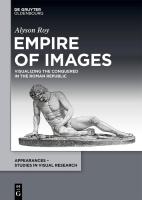
De Gruyter (2024) h/b 166pp £82 (ISBN 9783111325347)
This is a study of ‘conquest imagery’, though actually over the last two centuries of the Roman Republic rather than the Empire. Its author, Alyson Roy, rightly sees the origins of how imperial power was portrayed as lying in the earlier Republican campaigns in Gaul, Greece and the Iberian peninsula. Through these three lenses she shows how the principal imagery of trophies, bound captives and their captured weapons developed through monuments, statues, coinage and later in domestic design. Its production in these newly acquired provinces necessarily involved local artisans and mints, and some ambiguity therefore in how they acknowledged the immediate past. It is this interaction between defeated and conqueror that takes scholars such as R. into the complexities of ‘co-writing’ and ‘over-writing’. This is a study for specialists, requiring understanding of terms such as synecdoche and commensuration, and able to cope with rather academic language (‘locals coopted Roman imagery to reify social relationships’).
In Gaul warriors were portrayed in defeat as naked, wild and armed. Though both the well-known Dying Gaul monument and the Civitalba frieze in fact reflect Hellenistic origins, these new western barbarians similarly appeared as heroic but beaten figures. Coins illustrated defeat with captured shields, spears and trumpets alongside long-haired, bearded nude warriors. The images of Caesar’s campaigns empathise subjugation: captive warriors bound and seated, often with their women.
In Spain the imagery was slightly different. Iberians were not a centralised trope, perhaps because they lacked any heritage in Greek ethnography. But Iberia was particularly influential in early Roman coinage, already producing half the Republic’s silver. According to R. coins began to show ‘co-written’ symbols of cohesion between locals and Roman authority: unlike monuments, trophies and temples coins were flexible, varied and often reworked annually. Their messages were political, disseminating values and expectations of behaviour: war was linked to virtus. Over long periods, even if they were not all carrying explicitly political messages, they helped to diffuse ideals and to advance Roman hegemony. Coins of course were equally aimed at the home audience, communicating past, present and future. Those minted for rival campaigns differed: images of subjugation for Caesar, the support of local cities for Pompey. As the Romans extended their authority over the peninsula, coinage after the Sertorian war (82-72 BC) showed how Roman values began to be blended with indigenous imagery. Locals were learning how to re-imagine the new empire as one of local equals.
Greece (including Macedonia) was different again, being complicated by its cultural legacy. While Gaul and Spain were being conquered, the Romans were ‘commensurating’ Greece city by city, with monuments, statues, inscriptions and coinage that drew heavily on local iconography. Existing monuments in the most significant commemorative sites such as Olympia and Delphi were adapted by the new rulers: Paullus overwrote the Perseus monument in Delphi; Antonius overwrote the Altar of Ahenobarbus to promote his victory over pirates in 102 BC and added a panel showing a census procession. The first Roman to appear on coinage before Julius Caesar was Flaminius whose gold stater (196 BC) asserted Roman hegemony in Macedonia as ‘freedom to all Greeks’. Sulla amended Athens’ well-known owl coinage. Much later Augustus commemorated his victory at the battle of Actium with a vast monument at Nicopolis decorated with the bronze prows of captured ships.
In the Western provinces the main displays were of captives and weapons; further east we begin to see art and luxury goods featuring. What was changing was the growing use of this kind of imagery by Roman elites. With relatively few Triumphs granted after those first provinces were pacified, ambitious Romans had to find other ways of competing with their peers. The social cachet of conquest imagery, R. believes, substituted for military achievement and morphed into luxury consumption, appearing in domestic spaces and on expensive and portable household objects such as lamps and jewellery. R. suggests that the increase in conquest imagery in the final century of the Republic reflected rapidly developing prosperity, a ‘prestige’ economy in which wealth flowed from one end of the Mediterranean to the other.
The visual culture of the Republic needs to be better understood, R. argues, as more than a backdrop to later imperial imagery. In these first provinces local peoples had several generations to negotiate the right relationship between image and power. Whilst visual media were initially used to present their conquerors’ personal achievements, non-Roman elites began to use imagery to navigate their own standing in the new Roman-dominated world.
Sir Michael Fallon
Founder of the All-Party Classics Group in Parliament
